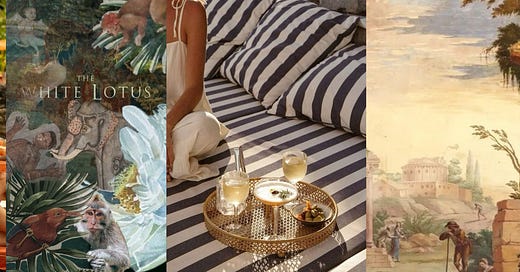Branding Lessons from The White Lotus
What The White Lotus teaches us about immersive brand experience and experiential research, from mood to service to setting.
What is Mondae Morning?
Each week, I explore how research, marketing, and design influence what we buy, use, and believe (particularly in the worlds of health + wellness, and wearable tech). With a background in UX research and public health, I share insights at the intersection of behavior, branding, and trust.
This newsletter is part commentary, part case study, but more importantly, a space to think out loud about the products shaping modern life, and the systems behind them.
For curious readers, researchers, and anyone designing for real people.
Renewed for a season 4, The White Lotus is a masterclass in brand recognition and immersive experience.
Though never explicitly named, the show is widely known to be inspired by (and filmed at) The Four Seasons. Across three distinct locations, this show offers something rare in hospitality: an emotional sample of a luxury resort for viewers who may never afford, visit, or even seek out the actual destination.
From sweeping coastal views to fashion-forward wardrobes and wellness-infused side plots, The White Lotus captures the essence of a high-end experience without delivering a single booking - and yet, it hooks millions. Like Yellowstone did for the modern Western fantasy, The White Lotus sells an entire lifestyle, with even more restraint. In essence, it markets luxury without saying a word.
This is hospitality branding at its most subtle and strategic. It’s highly designed, emotionally resonant, and immersive in ways that transcend price point or physical access. Even the product placement ads are subtle (did you notice all the HP product shots in season 3?)
In this week’s post, I’ll build on my recent piece about UX research in hospitality and offer a framework for researching and measuring intangible brand cues like mood, sound, scent, and lighting. Whether you're shaping a boutique hotel, a wellness app, or a luxury-adjacent experience, this week will help you translate aesthetic into something you can actually test, design, and deliver.
Read more from my first paid post here:
🔗 Turning Vibes into Value: UXR Strategies for Hospitality on a Budget
Why It Works: The Cultural Conditions
The concept of The White Lotus is a layered case study in modern brand storytelling. Its success sits at the intersection of cultural critique, experiential design, and emotional user experience:
1. Satire sells
The White Lotus is soaked in dark humor and class commentary, arriving at a time when public appetite for poking fun at the ultra-wealthy is at an all-time high. As Deuxmoi floods our feeds with Met Gala Mondays and mega-weddings (à la Jeff Bezos), The White Lotus offers a beautifully dressed eye-roll at elite excess, making viewers feel both outside and inside the joke.
UX Research Lesson: Brands that balance aspiration with self-awareness (like luxury with irony) can broaden their appeal. Ask yourself, what happens when you take your brand less seriously? Research can reveal where that tension sits for your audience. Ask customers: what feels elevated vs. alienating?
2. It’s built for discourse
The show’s social dynamics and simmering subtext are designed for decoding and theorizing. Each season invites audiences to play amateur sociologist, fueling Reddit threads, TikTok takes, and plot moments that extend its relevance beyond the screen.
UX Research Lesson: This is participatory storytelling. The show creates enough ambiguity and detail to spark co-creation. In brand experience, this mirrors how strong branding encourages meaning-making (e.g., signature scents, suggestive copy, or open-ended interfaces). Qualitative data on how people interpret an experience is key here. Even Taylor Swift built her empire on this principle of cultural usability by planting clues, leaving gaps, and giving fans space to piece the story together - it’s all intentional.
3. Escapism with edge
It offers viewers an escape fantasy that’s equally indulgent and self-aware. This layered experience makes it irresistible for audiences craving both aesthetic pleasure after a long day at work and cultural critique that makes them think.
UX Research Lesson: This is sensory branding at its most nuanced. The atmosphere is the product. As mentioned, the Four Seasons doesn’t need to be named because the feeling is so well-crafted. The same is true for products throughout the show as well. The outfits worn are a luxury cover spread for Gucci dresses, Jacquemus sunglasses, and many more designers. To replicate this, teams must explore how users feel in a space or when using a product, in addition to what they are doing in the space / the product’s purpose. Consider contextual inquiries, emotional journey mapping, and/or environmental cue testing. What products are customers using alongside yours?
Takeaways for Brand Builders
Signal Brand Without Saying It
The most iconic branding often happens through atmosphere, not logos. Use sensory signals such as sound, micro-copy, color, timing, interaction design, to build recognition without being overt. Brand perception are shaped in the margins.Build for Participation
The White Lotus succeeds by inviting interpretation. Marketers and designers can do the same by creating open-ended experiences such as customizable features, experiences, or accessories, allowing users co-author the brand.Captivate your Audience by Measuring What’s Hard to See
UX teams and marketers often skip intangible elements like tone, ambience, and tension (this is especially true for teams working on physical form factors), but these shape behavior. Pair qualitative insight (e.g., comparisons, body language, verbal pauses) with creative quantitative metrics (e.g., time spent in non-required features, or hesitation time before action) to evaluate brand atmosphere.
Some final thoughts:
Building an iconic product means building emotional memory. Brand loyalty is earned through the details users feel but can’t always name. When researchers and designers lean into the intangible mood, meaning, and symbolism, they stop selling, and start storytelling.
📌 Read more thoughtfully created articles here
💬 Chat with me on LinkedIn





